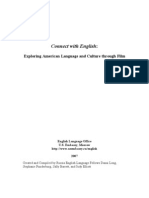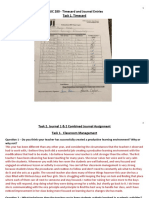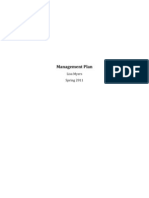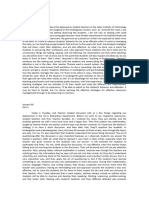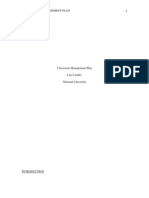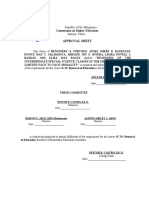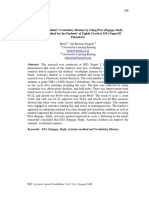Kicklighter Classroom Management Plan
Kicklighter Classroom Management Plan
Uploaded by
api-216664034Copyright:
Available Formats
Kicklighter Classroom Management Plan
Kicklighter Classroom Management Plan
Uploaded by
api-216664034Original Title
Copyright
Available Formats
Share this document
Did you find this document useful?
Is this content inappropriate?
Copyright:
Available Formats
Kicklighter Classroom Management Plan
Kicklighter Classroom Management Plan
Uploaded by
api-216664034Copyright:
Available Formats
Apprentice Teaching in Secondary Mathematics and Science
Classroom Management Implementation Plan
Completed Instrument Due: Monday, October 27
Observer: Deanna Kicklighter
Class Date: October 21 & 23
Class Location: GHS
Class Time: 3rd Period
Name of Class: Math for College Readiness
Observed
1 and 2
Rules, Routines and Procedures
Classroom rules
1. Posted.
2. Emphasize appropriate behavior.
3. Adhered to without exception.
1, 2, 3, 4, 5,
6, and 7.
Classroom routines and procedures are taught and
practiced.
1. Getting students attention.
2. Beginning and ending of class
3. Materials acquisition, distribution and
collection.
4. Sharpening pencils, heading papers, etc.
5. Students who are tardy, returning from an
absent, or absent from class.
6. Incomplete or missed work.
7. Expectations for group work, seatwork and other
activities.
Number of students: 28
Observed impact on student behavior
The classroom rules are posted on a bulletin board in the
back of the room. There is also a NO CELL PHONE
sign that is posted on the outside of the classroom door
and in multiple locations inside of the classroom.
Appropriate behavior is emphasized in the classroom
with regards to be ready to start class when the bell rings,
coming to class prepared, not having food or drink out,
being respectful to peers and teacher, and obeying dress
code. All of these rules are adhered to and followed.
However, one rule that the students tend to push is the no
cell phone rule they will not necessary have it out and
be texting/etc but they will have their music playing
through headphones. Almost every day Ms. Long has to
tell someone to take their headphones out and turn off
their phones. So, I would say that this room is not being
adhered to without exception. Due to this leniency,
students continue to bend this rule and see if they can
get away with listening to their headphones and not get
caught.
The students are in a good routine of coming in and
getting in the mindset to work. If for some reason the
students get loud, Ms. Long uses a whistle to get their
attention. At the beginning of class, students have a
routine of taking out their hw from the previous night and
checking it. The students do not have a routine or
procedure for ending the class (with the exception of first
period ending with the announcements). As far as
collection goes, all classes have a bin on the right side of
the room. All work that is to be collected is turned in
through there. When work is to be distributed back to the
students, Ms. Long asks for volunteers to turn work back
at the end of the period. The students also have a routine
for using their textbooks. The students in 2nd period are
responsible for getting a textbook for that desk for
students in the remaining classes to use. Students in 5th
period are responsible for returning the textbooks back
onto the shelf at the end of every day. Students also have
a routine with turning in their hw assignments for all
hw assignments, they must show all work and highlight
their final answer. For students who are absent, they are
given 3 days to turn in make-up work, but if students
were present and do not do hw they receive a 0. If
students turn in hw without showing their work or
completing the assignment 100%, they receive an
incomplete (0). Students are not permitted to make-up
incomplete work. The expectations for seatwork are to
stay on task, and they may work with one another to
complete assignments. There has not been an activity that
was specifically designed as group work. With that, it
Apprentice Teaching in Secondary Mathematics and Science
seems to me that the students are in a good routine for her
classroom.
~1, 2, ~3, 4,
and 5
2, ~3, 4, ~7,
8, and 9
~1, 2
Physical Environment
1. All students can see presentation of instruction.
2. Teacher can observe all students at all times.
3. Furniture arranged to facilitate learning and
maximize space.
4. Classroom is attractive, bulletin boards are
current and student work is displayed.
5. Frequently used materials are accessible.
Instruction and academic work
Teacher
1. Varied teaching strategies.
2. Well-planned lessons at appropriate level for
students.
3. Assignments are relevant and meaningful to
students.
4. Clear questions/directions/instructions.
5. Balanced interactions with students.
6. Circulates around the classroom.
7. Utilizes formative assessment to guide the
lesson.
8. Positive atmosphere and expectation for success.
9. Appropriate praise-tell them when they excel
and how to improve.
Student
1. Attentive and on task.
2. Accountable for their work.
Due to the shape of the room, it is difficult for students
sitting on the far right side of the room to see any
presentation that is done on the board to the far left side
of the room. With the set-up of the rows, it is easy to
observe students at all times, although it is a tight squeeze
between the rows. Again, with the shape of the room and
the location of Ms. Longs desk, the desks are arranged as
best as they can be to facilitate learning. However, the
arrangement of the desks could facilitate learning so
much more if it were different. As of now, the desks are
only in rows and it is difficult to circulate and for students
to work together on problems. The appearance of the
classroom is cool Ms. Long has multiple pieces of
student work displayed around the room and there is an
informative bulletin board in the back to the room. Ms.
Long also has an agenda posted on the front white board
that contains the topic for today, hw for today, and hw
from the previous day for those that were absent. All
materials are accessible for all students. With this being
said, it seems to me that students could be engaged more
and should be checked to see if they are able to see the
presentation of instruction.
Ms. Long only uses direct instruction. With that being
said, her lessons are always planned out ahead of time
with examples that she is going to use that are at the
appropriate level for the students. The assignments that
assigned for hw do correlate and are aligned with the
lesson that she gives, but most of the time do not make
any connections as to why they are important and
relevant to the students. Ms. Long does always give clear
directions and instructions in here lessons and in her
examples. The questioning in her lesson is limited, but
when she does ask questions, they are clear. There is little
or no interaction with the students. Due to the direct
instruction, there is not a lot of room for student
interaction in the lesson. This causes the students to start
on the hw while Ms. Long is teaching the lesson, or glaze
over and not pay attention. Ms. Long does not circulate
around the room. Once she is done with instruction, she
returns to her desk. The only formative assessment is
what the students turn in for hw. Ms. Long is very
enthusiastic and motivating for the students. These
students are seniors and sometimes they need a little extra
push to get them through the day and Ms. Long gives that
to them. When students are struggling with a certain type
of problem or area, she tries to explain it in a different
way or breaks it down into smaller steps which really
helps the students.
With the class being so big, most of the students stay on
task but there are a few who choose to not use their time
wisely. Ms. Long makes them be accountable for their
work by making them turn it in the next day. If students
did not show all work for every problem, she gives them
an incomplete and they are not allowed to make it up.
Apprentice Teaching in Secondary Mathematics and Science
1, 2, 3, 4
1,
Discipline
Teacher
1. Calm, fair and consistent in word and deed.
2. Models positive behavior.
3. Knows students names.
4. Demonstrates respect for students.
5. Addresses conflict quickly and positively.
6. Consequences for inappropriate behavior.
Student
1. Understands and has been taught the rules.
2. Understands there will be consequences for
inappropriate behavior.
3. Student takes responsibility for his behavior.
Ms. Long is very patient with the students when learning
new and difficult material. She is very consistent in how
she teaches and deals with students who struggle. She
also offers tutoring every Tuesday and Thursday for those
who are struggling. Ms. Long also models positive
behavior which shows through the behavior of her
students. When I first started, I was worried about them
not respecting me, but they give me the same respect that
they give Ms. Long. Ms. Long does know their names
and when she accidentally calls someone by the wrong
name, she immediately goes No, thats not you, hold on,
dont tell me and the kids usually laugh and she
remembers their name. There is a mutual level of respect
and it shows. She treats every student fairly and the same.
There is no student who gets special treatment and she
treats them like adults, which I feel that they respect her
more for this. Being that they are about to graduate, they
respect her more for treating them like they are not kids.
There has not been any conflict for me to observe how it
was handled. There has not been any inappropriate
behavior for me to observe how it was handled.
All students know the rules and procedures and it shows
when they students come in and immediately take out
their hw to begin checking, when Ms. Long starts to talk,
they stop talking, and for the most part they do stay off
of their phones. There are a few who try to listen to music
off of it and she tells them to put it away. So far, she has
threatened to write people up, but has not done so yet.
After observing the classroom and the students behavior reflect on the following:
1. Think about how rules, routines, and procedures are established and why they are important to your classroom learning
community. List a set of general classroom and/or laboratory rules, routines and procedures and briefly describe how you plan to
implement rules, routines and procedures in your classroom and how they contribute to the functioning of your classroom learning
community.
Rules:
1) Come to class prepared every day. This means you have your textbook, pencil, paper, and any homework that was
assigned to you.
2) Have a positive attitude and be willing to participate in class.
3) Respect both your teacher and your fellow peers.
4) Put away cell phones unless asked to have them out.
Having these rules set in place will assure that valuable class time is not wasted on things such as making sure that they
have paper and pencil for the day. These rules will also help create a positive and safe environment for students to learn.
Procedures:
1) Come into class ready to being working on the Bell Ringer.
2) Turn in all HW to the appropriate basket.
a. Label your paper with your First and Last Name, Assignment, and Period
b. You must show all work to receive credit.
c. Highlight final answers.
3) Sign In and Out for using the bathroom.
4) You may not leave class until you have completed the Exit Slip for the day.
These procedures will ensure that the students are working bell to bell and not wasting any time during class. It will also
provide smooth transitions from one activity to the next. For example, having a Bell Ringer up on the board will create a
routine of coming into class and getting down to business and not spending 10 minutes getting students to sit down, be
Apprentice Teaching in Secondary Mathematics and Science
quiet, and get ready for todays lesson. By having the Bell Ringer, they will have something to do as soon as they come
into the classroom.
2. Observe the physical environment of your mentors classroom. Draw a floor plan of your mentors classroom, paying attention to
the arrangement of furniture and materials and the impact on student behavior. Label the different areas and write a short explanation
of how different areas are used and whether and how this supports the classroom learning community.
Counter
Table
Whit
eboa
rd/
SMA
RTB
OAR
D
Desk
Desk
Desk
Desk
Desk
Desk
Desk
Desk
Desk
Desk
Desk
Desk
Desk
Desk
Desk
Desk
Desk
Desk
Desk
Desk
Desk
Desk
Desk
Desk
Desk
Desk
Desk
Desk
Desk
Teacher Desk
Water
Fountain
Desk
Book Shelf
With the set-up of this room, it is very easy for the students in the back rows and the very far corner (closest to the water fountain) to
become off task when Ms. Long goes to her desk after giving instruction. It is also a very crowded room and hard to circulate around
the room to enforce that students are staying on task. The arrangement of the room also makes it very hard for students to see the
instruction on the board. There is also one student who is in a row (or column) all by their self and it kin-of isolates them from the rest
of the class when students are working in small groups. The room is very cramped. The book shelf is used every day and so is the
counter space this is where students turn in their work. I feel that this room limits the learning community feeling due to how
crowded and cramped the room is.
Apprentice Teaching in Secondary Mathematics and Science
3. After observing the teacher and student behaviors associated with instruction and academic work, reflect on the impact the
observed behaviors have on creating the classroom learning community. Discuss your plans for instruction and academic work and the
learning community you hope to create in your classroom.
The behaviors of students in regards to instruction and academic work are coming along better and better with each week. In
the beginning of the semester I noticed that the majority of the students were not paying attention during instruction and were not
completing any homework. Now, most of the students are paying attention and completing their homework. However, with more
student interaction, I feel that the students would be more involved in their work and be willing to participate in discussion. As for my
classroom, I hope to create a learning community that encourages classroom discussion and student exploration. These two elements
can completely change the environment of the classroom and engage students more. For my instruction, I hope that I can find
activities and/or videos that will engage the students and give them the opportunity to explore topics without straight direct instruction.
It will definitely be tough but this is my goal for my classroom. It may be not be able to happen every day but I will strive to have this
happen at least once a week. As far as academic work goes, I feel that students should be held accountable for completing their work.
Instead of going over homework problems before class starts, I will probably quickly check students hw as they complete the bell
ringer and if students have any questions about the hw from previous night, we will go over 1 or 2 problems at the end of the period
instead of completing an exit slip for the day.
4. Observe the teacher and student behaviors associated with discipline in your mentors classroom. Describe the most effective
techniques used by your mentor teacher when dealing with student behavior. Include any additional techniques you would implement
in your classroom.
The most effective technique that I have seen is having respect for the students. I have not encountered a time where a student
has acted out and Ms. Long has had to deal with them. There have not been any behavior issues in the classes that I have observed, so
I am hoping for the same outcome when I have my own classroom. I know that the level of respect that Ms. Long has with her
students is something that I will have to build over time with my students. I hope to accomplish this by holding students accountable
for their actions and when they do misbehave, they are punished accordingly, whether it is an after-school detention with myself, a
parent phone call, a parent conference, or referral.
You might also like
- Connect With EnglishDocument48 pagesConnect With Englishwilhem12100% (7)
- Attending To The LearnerDocument6 pagesAttending To The LearnerRDRI100% (2)
- Classroom Management Plan-1Document10 pagesClassroom Management Plan-1api-285220765100% (1)
- Observation ReportDocument6 pagesObservation ReportDon Chiaw Manongdo100% (4)
- Edu202 ObservationDocument11 pagesEdu202 Observationapi-315099021No ratings yet
- Behavior Change Project p2Document8 pagesBehavior Change Project p2api-241524310No ratings yet
- Classroom Management PlanDocument5 pagesClassroom Management Planapi-385384321No ratings yet
- Observation AssignmentsDocument9 pagesObservation Assignmentsapi-585739917No ratings yet
- Classroom Management and Discipline Plan Mary Baldwin University ED 625WA Classroom and Behavioral Management: Theory and PracticeDocument8 pagesClassroom Management and Discipline Plan Mary Baldwin University ED 625WA Classroom and Behavioral Management: Theory and PracticeLauren ElmoreNo ratings yet
- Kounin and Classroom ManagementDocument5 pagesKounin and Classroom Managementsarboukhk100% (1)
- Fieldwork Packet Edu 518 Daniela CupplesDocument34 pagesFieldwork Packet Edu 518 Daniela Cupplesapi-28847298No ratings yet
- Edu 201 Field Observation EssayDocument6 pagesEdu 201 Field Observation Essayapi-550363606No ratings yet
- Field Observation NotesDocument14 pagesField Observation Notesapi-271122505100% (1)
- Tlac 2Document7 pagesTlac 2api-302405971No ratings yet
- Observation Notes For Students CsafodreaDocument9 pagesObservation Notes For Students Csafodreaapi-247283121No ratings yet
- Lauren MarksDocument10 pagesLauren Marksapi-549327571No ratings yet
- Field Study 1 Episode 3Document7 pagesField Study 1 Episode 3Noreen Mejes RiegoNo ratings yet
- Classroom Management PlanDocument7 pagesClassroom Management Planapi-264154243No ratings yet
- Educ 1301 - Field Experience 2Document10 pagesEduc 1301 - Field Experience 2api-610903961100% (1)
- EbookDocument9 pagesEbookapi-295498767No ratings yet
- Contextual Factors 2014Document3 pagesContextual Factors 2014api-253021879No ratings yet
- Field Observation AssignmentDocument14 pagesField Observation Assignmentapi-357243102No ratings yet
- Classroom Environment Philosophical Statement On Your Beliefs About Classroom ManagementDocument9 pagesClassroom Environment Philosophical Statement On Your Beliefs About Classroom Managementapi-267503852No ratings yet
- Field ObservationDocument11 pagesField Observationapi-510560608No ratings yet
- Classroom Management PlanDocument7 pagesClassroom Management Planapi-269287243No ratings yet
- Classroom Observation Assignment - Form 1 - Sabri UnalDocument3 pagesClassroom Observation Assignment - Form 1 - Sabri Unalapi-459783199No ratings yet
- Management and MotivationDocument5 pagesManagement and Motivationapi-295128690No ratings yet
- Educ 540 Journal ReflectionDocument6 pagesEduc 540 Journal Reflectionapi-453835770No ratings yet
- Classroom ManagementDocument4 pagesClassroom Managementapi-251338363No ratings yet
- Holdman - Classroom Management Implementation PlanDocument4 pagesHoldman - Classroom Management Implementation Planapi-210118947No ratings yet
- Observation Document-4Document7 pagesObservation Document-4api-302377124No ratings yet
- Managementplan MaryDocument6 pagesManagementplan Maryapi-265956819No ratings yet
- Field ObservationDocument12 pagesField Observationapi-594749256No ratings yet
- Educ 280 Signature AssignmentDocument8 pagesEduc 280 Signature Assignmentapi-416199376No ratings yet
- Management PlanDocument14 pagesManagement PlanLisa MyersNo ratings yet
- Observation and Reflection 1Document4 pagesObservation and Reflection 1Matet Sales AsuncionNo ratings yet
- Copy of Edu221slreflection 1Document4 pagesCopy of Edu221slreflection 1api-746381002No ratings yet
- Tws 1Document31 pagesTws 1api-178835443No ratings yet
- Tefl 3Document40 pagesTefl 3Mala Cahya IlNo ratings yet
- Observation Assignment For 4th GradeDocument11 pagesObservation Assignment For 4th Gradeapi-311761572No ratings yet
- PPST Domains JournalDocument3 pagesPPST Domains JournalGia CrystalNo ratings yet
- Nastasha Green Tws 9 DoneDocument7 pagesNastasha Green Tws 9 Doneapi-235236877No ratings yet
- Nastasha Green Tws 9 DoneDocument4 pagesNastasha Green Tws 9 Doneapi-235236877No ratings yet
- Artifact 2Document10 pagesArtifact 2api-564594529No ratings yet
- Classroom Management PlanDocument12 pagesClassroom Management Planapi-252894921No ratings yet
- Field ObservationDocument6 pagesField Observationapi-584167005No ratings yet
- ClassmanDocument5 pagesClassmanapi-281590599No ratings yet
- Danielle Bryan Fieldobservationquestions 2Document10 pagesDanielle Bryan Fieldobservationquestions 2api-711925909No ratings yet
- ModifiedhistorylessonDocument16 pagesModifiedhistorylessonapi-196056099No ratings yet
- Edu 201 PacketDocument7 pagesEdu 201 Packetapi-610699050No ratings yet
- Classroom Management PlanDocument16 pagesClassroom Management PlanLara LandryNo ratings yet
- Field Observation ReportsDocument4 pagesField Observation Reportsapi-378342604No ratings yet
- Artifact 1Document6 pagesArtifact 1api-384485057No ratings yet
- Reflection 1Document4 pagesReflection 1api-381391951No ratings yet
- Megan Davison: Classroom Management PlanDocument5 pagesMegan Davison: Classroom Management Planapi-215072694No ratings yet
- Bilek Halim Classroom Observation Assignment-Form 1Document5 pagesBilek Halim Classroom Observation Assignment-Form 1api-322653911No ratings yet
- Daily JournalsDocument19 pagesDaily Journalsapi-431079208100% (1)
- Classroom Management PaperDocument9 pagesClassroom Management Paperapi-340608633No ratings yet
- Data and Observation WorksheetDocument4 pagesData and Observation Worksheetapi-343444973No ratings yet
- Lbs 302 Managment Plan FinalDocument9 pagesLbs 302 Managment Plan Finalapi-452832924No ratings yet
- Observation Packet Edu 203Document4 pagesObservation Packet Edu 203api-533889645No ratings yet
- Kicklighter Environment ReflectionDocument7 pagesKicklighter Environment Reflectionapi-216664034No ratings yet
- Formative Assessment KicklighterDocument19 pagesFormative Assessment Kicklighterapi-216664034No ratings yet
- Kicklighter Colontonio 2daylessonfinalDocument26 pagesKicklighter Colontonio 2daylessonfinalapi-216664034No ratings yet
- Project RubricDocument2 pagesProject Rubricapi-216664034No ratings yet
- A Comparative Analysis of Student Performance in An Online VsDocument28 pagesA Comparative Analysis of Student Performance in An Online VsFarida Priela OlleresNo ratings yet
- Soal Try Out Abi BingDocument4 pagesSoal Try Out Abi BingAtika Ayu NuraniNo ratings yet
- Rules and Reminders For Online Classes 2Document14 pagesRules and Reminders For Online Classes 2api-220703221No ratings yet
- Lesson 1 Lets Read This 3Document15 pagesLesson 1 Lets Read This 3Juls PanchoNo ratings yet
- Creating Active Learning StrategiesIn SummaryDocument4 pagesCreating Active Learning StrategiesIn SummaryClaudine TubleNo ratings yet
- Teaching Strategies For Special Students: Dr. Abowaba Johnson Idowu Kings (PHD, Edd)Document9 pagesTeaching Strategies For Special Students: Dr. Abowaba Johnson Idowu Kings (PHD, Edd)fariez79No ratings yet
- MCT English Lesson ReflectionDocument3 pagesMCT English Lesson ReflectionJwaherNo ratings yet
- Whole Class ProfileDocument10 pagesWhole Class Profileapi-570083557100% (1)
- Tws 5Document12 pagesTws 5api-246132572No ratings yet
- Self Reflection and EvidenceDocument3 pagesSelf Reflection and Evidenceapi-277678620No ratings yet
- Executive Summary (Student Sample 2) : SpeakerDocument5 pagesExecutive Summary (Student Sample 2) : SpeakerNguyen Thi Ngoc MienNo ratings yet
- Part3 SingleDocument8 pagesPart3 Singleapi-224515604No ratings yet
- Chappuis Assessment Chap 1Document16 pagesChappuis Assessment Chap 1SethycNo ratings yet
- Assignment 7 - Emerging TechnologyDocument8 pagesAssignment 7 - Emerging Technologyapi-522778954No ratings yet
- Making Words LPDocument6 pagesMaking Words LPapi-282019703100% (1)
- 15 Ways To Become A Smarter TeacherDocument15 pages15 Ways To Become A Smarter TeacherchayontNo ratings yet
- Group 3 Beed 3a Thesis 1 1 1Document54 pagesGroup 3 Beed 3a Thesis 1 1 1Angel D. BaybayanNo ratings yet
- Caltex at RSHS: Creating An Ambiance For Learning and Teaching Experience About Me Eva Paulette A. CruzDocument6 pagesCaltex at RSHS: Creating An Ambiance For Learning and Teaching Experience About Me Eva Paulette A. CruzAnse FraiwinNo ratings yet
- The Laptop in Schools ProgrammeDocument84 pagesThe Laptop in Schools ProgrammeAbdulwahid S. UlangkayaNo ratings yet
- NCBTS Volume 1 Principles Edtec Curdev Devread FS 01 50Document102 pagesNCBTS Volume 1 Principles Edtec Curdev Devread FS 01 50justin may tuyorNo ratings yet
- Administering The TestDocument3 pagesAdministering The TestAila Elocin PalmasNo ratings yet
- Edtpa Pfa Context For Learning FinalDocument4 pagesEdtpa Pfa Context For Learning Finalapi-3031605560% (1)
- Challenges Faced by Mainstream Teachers in Inclusive Education - EditedDocument6 pagesChallenges Faced by Mainstream Teachers in Inclusive Education - EditedKristin Muriuki100% (1)
- Curr-Hand in Hand - Student Book 1Document17 pagesCurr-Hand in Hand - Student Book 1Agui ChaiNo ratings yet
- Autobiography - Emalea BriggsDocument2 pagesAutobiography - Emalea Briggsapi-490916133No ratings yet
- Improving Students' Vocabulary Mastery by Using Esa (Engage, Study, Activate) Method For The Students' of Eighth Grade at Mts Negeri 02 PekanbaruDocument11 pagesImproving Students' Vocabulary Mastery by Using Esa (Engage, Study, Activate) Method For The Students' of Eighth Grade at Mts Negeri 02 PekanbaruAndriany SuciarahmanyNo ratings yet
- 0 Lesson Plan Junk FoodDocument4 pages0 Lesson Plan Junk FoodOleg RussuNo ratings yet
- Social Imagination ProjectDocument3 pagesSocial Imagination Projectapi-582076623No ratings yet
